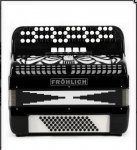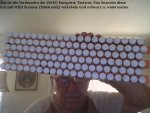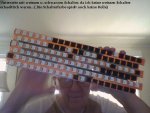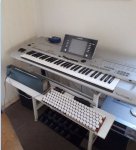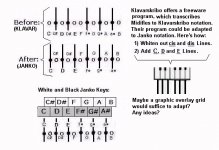If useful for your 6+6 Janko accordion, I have a few more hyperlinks with documents about uniform 6+6 PA keyboard layouts.
Heinrich Josef Vincent (1875): Die Neuklaviatur (The "new" PA layout 6+6, you can find a lot about grip schemes and fingering here):
The Virtual Laboratory - Essays and Resources on the Experimentalization of Life between 1800 and 1930
vlp.mpiwg-berlin.mpg.de
This person has uploaded some YT videos with a 6+6 uniform keyboard PA accordion:
Säkkijärven polka - Håkan Widar , Uniform Keyboard accordion
You probably already read this article about the history of the 6+6 PA layout:
http://www.le-nouveau-clavier.fr/english/
The earliest mentioning about a whole tone keyboard 6+6 layout was by Juan Caramuel y Lobkowitz (1606-1682) around 1654 in Prague.
Patrizio Barbieri: “Juan Caramuel y Lobkowitz: Uber die musikalischen Logarithmen” (point 3, pages 153-156 , a sketch of the history of many "inventors" of this 6+6 layout, Barbieri says there are way too many "inventors" to list up in his article, hundreds of persons have claimed to be the inventor in the 19th century of this 6+6 layout).
Barbieri, Patrizio. "Gli ingegnosi cembali e 'violicembali' inventati da Juan Caramuel Lobkowitz per Ferdinando III (c. 1650): notizie inedite dal manoscritto Musica", Comune di Vigevano, Vigevano, 1990, pp. 91-112.
Grip schemes for triads for whole tone keyboards:
http://www.thecipher.com/wholetone-keyboard_triads.html
Gardner Read is a must read for everyone interested in the history of music notation reforms.
About new music notation reforms, here is another recent notation system that tries to simplify music notation, called "Notus":
http://shop.notus.world/en
http://shop.notus.world/en/basics-examples
(I'm sticking to my personal favorite, the numbered music notation by Emile-Joseph-Maurice Chevé, a music key independent notation system, based on relations between notes. Because my CBA accordion also is a key independent equal intervals music instrument. It's a marriage made in heaven. )
If you are looking for reasons why Paul von Janko used a 6 rows keyboard, I'm sure you can find some answers in his 1886 (online !) 68 pages book in German:
Jankó, Paul von. 1886. Eine neue Claviatur. Theorie und Beispiele zur Einführung in die Praxis. Wien: Verlag von Em. Wetzler (Julius Engelmann) (Staatliches Institut für Musikforschung)
Janko has inserted fingerings and grip schemes in his 1886 booklet.
you can read or download it here:
The Virtual Laboratory - Essays and Resources on the Experimentalization of Life between 1800 and 1930
vlp.mpiwg-berlin.mpg.de


